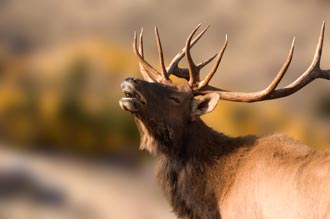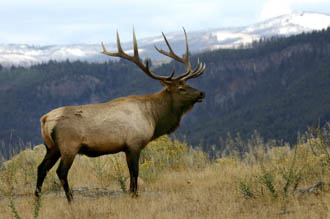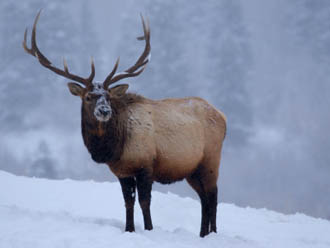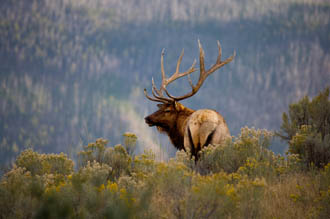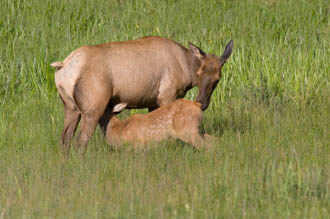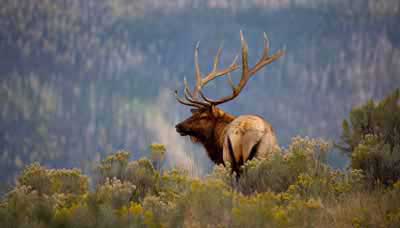
Before European settlers migrated to North America, there were an estimated 10 million elk spread through every part of the continent except the Great Basin Desert and the Southern coastal plains. Because of settler expansion and market hunting, the total North American elk population had dwindled to about 90,000 by 1922 and about 40,000 of those were concentrated in the Yellowstone Park area. In 1913, 83 elk from Yellowstone were transplanted in Arizona near Chevelon Lake in the Arizona White Mountains region. Even with harvesting via licensed hunting, today the Arizona elk population has grown to about 35,000.
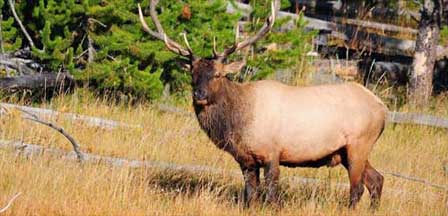
Characteristics and Behavior
A large bull elk can weigh up to 1,200 pounds but average from 600 to 800 pounds and an adult cow will range from 450 to 600 pounds. They are the second largest animal in the deer family with the moose being the largest. Elks can attain speeds up to 40 miles per hour over short distances and can sustain speeds of 30 miles per hour for long periods. Elk are strong swimmers and can leap vertically 8 to 10 feet.
A bull elk’s average life span is 14 to 16 years and the cows average a year longer. They have been know to live as long 25 years. Antler development is a function of age. The antler cast occurs in January to March for adult bulls and from March through May for sub-adults. New growth occurs shortly after the cast. The growing period ranges from 90 days for yearlings to 150 days for adult bulls. Therefore it’s possible to see yearlings with old spikes at the same time as bulls with a foot of velvet. Cows do not have antlers.
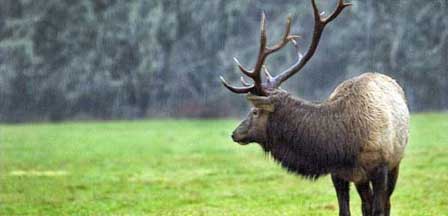
By early August, antler growth is complete. The velvet dries up and the antlers harden. The velvet is stripped off in a matter of hours and the elk polishes its antlers against trees. By early September, the bull is ready for the rut (mating). Bugling and harem formation occurs. Harems may number up to 30, depending on the vigor of the bull, but usually average 15 to 20 cows.
After mating, the cow will separate from the herd and seek out dense cover to prepare as a nursery. She will drive off last year’s calf only weeks before parturition. Twins are extremely rare. At birth, calves average nearly 30 pounds with males averaging 4 pounds more than cows. Within hours, a newborn calf can move and is led from the birthing spot to a safer place.
After a week, the female will band with other females and after two to three weeks the calves, now able to run, will join the group creating herds numbering in the hundreds. By September, the calves have shed their juvenile spotted coats.
Arizona Habitat
Elk inhabit forested areas at high altitude within a range where a water source is nearby. They prefer the higher elevations from 7,000 to about 10,000 feet which is referred to as their “summer range”. They will migrate to lower elevations during the winter when heavy snow forces them to seek lower ground. Their typical habitats include the White Mountains area, the Mogollon Rim and the Kaibab Forest.
Herds can commonly be seen in the areas around Flagstaff, Williams, Payson, Heber Overgaard, Show Low, Pinetop Lakeside, Greer, Alpine and generally any forested area. They feed primarily on grasses, shrubs and tree foliage. Their predators include mountain lions and packs of coyotes that will attach young elk.
Although elk are timid, with expansion of home developments into their natural habitats, elk will graze within communities. As long as humans do not approach them, they usually will permit people to watch them as they graze. They are beautiful animals and if you come across a herd, just sit quietly and enjoy these majestic animals.
When you drive through forested country, always be on the lookout for elk. Every year there are many incidents of elk suddenly leaping onto roads and even freeways. At a weight of 800 to 1,200 pounds, those type of accidents can cause serious damage and can result in fatalities.
More Information
About Elk – Wikipedia
Elk Picture Gallery
